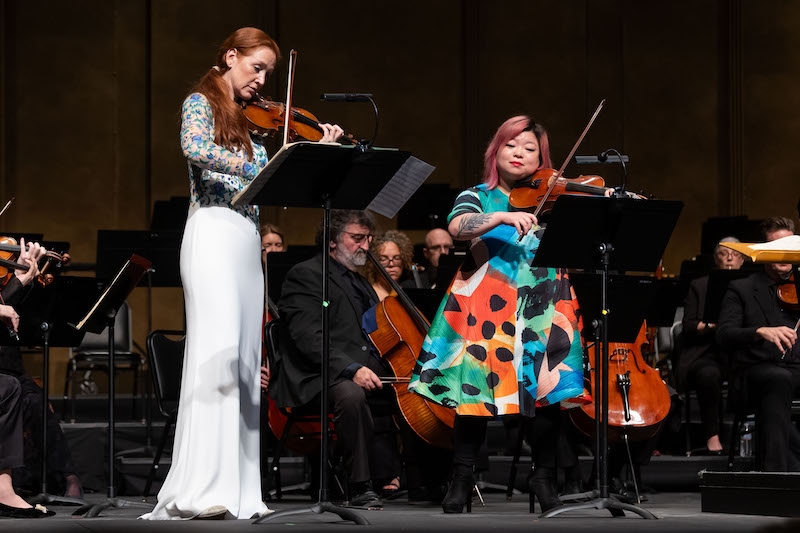REVIEW: Yura Lee and Tereza Stanislav Play Mozart with LACO
Violist-violinist Yura Lee and violinist Tereza Stanislav gave a truly stunning performance of Mozart's Sinfonia Concertante, along with the Los Angeles Chamber Orchestra (LACO) and Jaime Martín, Friday night at the Alex Theater in Glendale, Calif.
Performing Mozart's 1779 composition that casts violin and viola as co-protagonists, here were two musicians completely in step rhythmically, harmonically and aesthetically, like Mozartian musical twins. At the same time, they brought vividly different performance personalities to stage - and I'm not just talking about their outfits, although there was that: Stanislav in a white pantsuit with blue lace, Lee with pink hair and a colorfully abstract dress.

Violinist Tereza Stanislav and violist/violinist Yura Lee.
Tereza's demeanor was stoic and contained, while Yura's playing brimmed with kinetic energy. They performed on instruments made nearly 300 years apart - Tereza playing the 1714 "Leonora Jackson" Stradivari violin (on loan by Dr. William Sloan, who was in the audience), and Yura playing her 2002 viola by Douglas Cox.
Yet together, they created unity at an extraordinarily high level - with sound-melding intonation and strikingly precise coordination at every turn and trill.
They also seemed to be having a lot of fun with friends.
These soloists are both members of the orchestra - Tereza is one of LACO's veteran members, celebrating 20 years as the orchestra's assistant concertmaster this year; Yura (who is also well-known as a violinist) is among its newer members, having joined as principal violist about two years ago.
Standing together during the orchestral introduction, they began by turning away from each other to play with their respective sections - Tereza smiling as she connected with the first violins on stage right and Yura nodding as she joined with the viola section on stage left - the orchestra musicians making eye contact in return.
Then when it was almost time, each dropped out to face front, connect with each other and take up their roles as soloists, their first perfect-octave shared note rising in volume over the orchestra, then blooming into a shared melody. As they played, the orchestra's attention to detail - the well-calibrated crescendos, hushed dynamics to accommodate the solo voices, and attention to the changing pulse - helped carry off the balancing act.
When they played in unison, their parts truly blended as one. During individual solos, they showed individual personality, both with a wonderful sense of timing paired with the ability to seemingly bring time to a standstill.
To begin the second movement Tereza produced a beautiful dark sound from that "Jackson" Strad - a melodic voice on the edge of weeping. Then Yura took the same melody and teased the tension out of it - this exchange continuing, building with tension and excitement in the orchestra. During the second movement's cadenza, the two musicians matched each other - seemingly down to the individual oscillations in their trills.
The third movement was buoyant, with Tereza and Yura trading figures at times, playing together at other times - a graceful ride with energy in every note.
The audience responded with enthusiastic applause - an immediate standing ovation followed by three curtain calls. Dr. Sloan made his way to the stage, where Tereza reached down to take his hand.
The concert began with the world-premiere performance of Derrick Skye's "Prisms, Cycles, Leaps 3," with the composer in the house. This piece was rhythmically complex, clearly keeping LACO musicians on the edge of their seats. At times it felt atmospheric, and other times it grooved and coalesced into elements and effects described in the program notes: Ghanaian drumming, Persian classical music and Indian classical tala. There were plenty of effects - harmonics, glissandi, ricocheting bows, aleatory passages, quirky rhythms throughout. All this complexity often took place over a tonic drone - a centering element that was easy to connect with. It was a committed reading, and the music carried the listener to a variety of vistas.
And to conclude the concert: Beethoven. Played as LACO played it, Beethoven is ever fresh, ever relevant, and it doesn't matter which number the symphony, they are all masterworks. LACO happened to play Symphony No. 4 - one of the less-frequently performed of the nine. Beginning with a slow, low and sullen Adagio, it then burst into action, brisk and exciting under Martín's direction. Martín is clearly a musician's conductor. One of my friends, LACO violinist Joel Pargman, said it best: "He is like an artist who knows where not to put the paint." He doesn't conduct every beat - heck, for this piece he didn't even have a baton. But his motions are so apt - just what one needs to see to make the right thing happen at the right time - a nod, a sweep of the hand, a tiny see-saw syncopation, a flick of the wrist. Somehow this keeps LACO uncommonly en pointe. Plus it's so fun to watch.
The second movement "Adagio" was not too leisurely - "at ease" perhaps with a slightly elevated heartbeat. The third movement minuet, with its contrasting sections, had its own form of rhythmic complexity, and Martín handled this with nods and large gestures. The fourth movement was fast and buzzing with excitement - even at top speed, the multitude of notes in the busy string passages popped with accuracy. The humor at the end - a bit of half-speed before it tumbled to the end - came off with panache.
You might also like:
- Mozart's Sinfonia Concertante: Perspectives from Tereza Stanislav and Yura Lee
- Happy 300th Birthday to the 'Leonora Jackson' Stradivari Violin
- New LACO Director Jaime Martín's Secret Love: the Violin
* * *
Enjoying Violinist.com? Click here to sign up for our free, bi-weekly email newsletter. And if you've already signed up, please invite your friends! Thank you.
Tweet
Replies
This article has been archived and is no longer accepting comments.
Violinist.com is made possible by...
Dimitri Musafia, Master Maker of Violin and Viola Cases
International Violin Competition of Indianapolis
Violinist.com Holiday Gift Guide
Johnson String Instrument/Carriage House Violins
Subscribe
Laurie's Books
Discover the best of Violinist.com in these collections of editor Laurie Niles' exclusive interviews.

Violinist.com Interviews Volume 1, with introduction by Hilary Hahn

Violinist.com Interviews Volume 2, with introduction by Rachel Barton Pine







